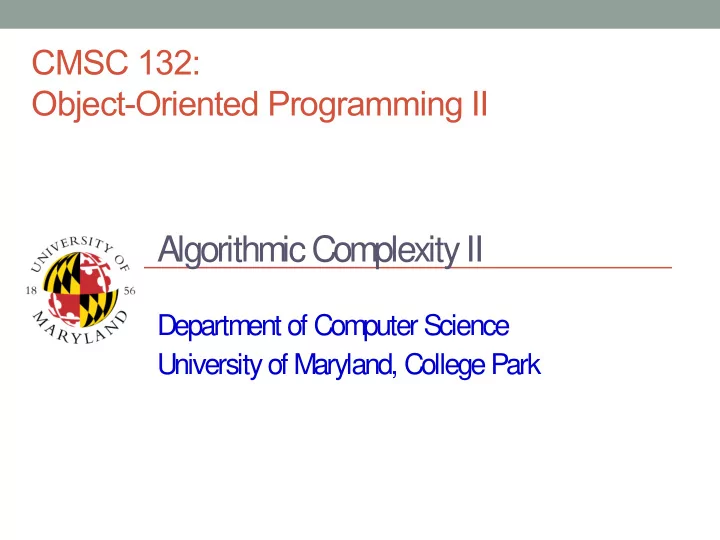

CMSC 132: Object-Oriented Programming II Algorithmic Complexity II Department of Computer Science University of Maryland, College Park
Announcements • Regarding Friday before spring break
Analyzing Algorithms • Goal – Find asymptotic complexity of algorithm • Approach – Ignore less frequently executed parts of algorithm – Find critical section of algorithm – Determine how many times critical section is executed as function of problem size
Critical Section of Algorithm • Heart of algorithm • Dominates overall execution time • Characteristics – Operation central to functioning of program – Usually contained inside deeply nested loops • Sources – Loops – Recursion
Critical Section Example 1 • Code (for input size n) A – for (int i = 0; i < n; i++) { – critical B – section } – C – •. Code execution A ⇒ once – B ⇒ n times – C ⇒ once – •. Time ⇒ 1 + n + 1 = O(n)
Critical Section Example 2 • Code (for input size n) A – for (int i = 0; i < n; i++) { – B – for (int j = 0; j < n; j++) { – critical C – – } section – } D – •. Code execution A ⇒ once – B ⇒ n times – C ⇒ n 2 times – D ⇒ once – •. Time ⇒ 1 + n + n2 + 1 = O(n2)
Critical Section Example 3 • Code (for input size n) A – for (int i = 0; i < n; i++) { – for (int j = i+1; j < n; j++) { – critical B – section } – } – •. Code execution A ⇒ once – B ⇒ ½ n (n-1) times – •. Time ⇒ 1 + ½ n2 – ½ n = O(n2)
Critical Section Example 4 • Code (for input size n) A – for (int i = 0; i < n; i++) { – for (int j = 0; j < 10000; j++) { – critical B – section } – } – •. Code execution A ⇒ once – B ⇒ 10000 n times – •. Time ⇒ 1 + 10000 n = O(n)
Critical Section Example 5 • Code (for input size n) for (int i = 0; i < n/ 2 ; i++) – for (int j = 0; j < n/ 2 ; j++) – critical A – for (int i = 0; i < n; i++) – sections for (int j = 0; j < n; j++) – B – •. Code execution A ⇒ n2/4 times – B ⇒ n2 times – •. Time ⇒ n2 + n2 = O(n2)
Critical Section Example 6 • Code (for input size n) – i = 1 – while (i < n) { critical A – i = 2 × i – section } B – •. Code execution i = 1 ⇒ 1 times – A ⇒ log(n) times – B ⇒ 1 times – •. Time ⇒ 1 + log(n) + 1 = O( log(n) )
Critical Section Example 7 (Recursion) • Code (for input size n) DoWork (int n) – if (n == 1) – A – else { – critical DoWork(n/2) – sections DoWork(n/2) – } – •. Code execution A ⇒ 1 times – DoWork(n/2) ⇒ 2 times – •. Time(1) ⇒ 1 Time(n) = 2 × Time(n/2) + 1
Comparing Complexity • Compare two algorithms f(n), g(n) – • Determine which increases at faster rate As problem size n increases – • Can compare ratio f(n) If ∞ , f() is larger – lim n → ∞ If 0, g() is larger – g(n) If constant, then same complexity – • Example ( log(n) vs. n½ ) f(n) log(n) lim lim 0 n → ∞ n → ∞ g(n) n ½
Additional Complexity Measures • Upper bound – Big-O ⇒ Ο (…) – Represents upper bound on # steps • Lower bound – Big-Omega ⇒ Ω (…) – Represents lower bound on # steps
2D Matrix Multiplication Example • Problem C = A * B – • Lower bound – Ω (n2) Required to examine 2D matrix • Upper bounds O(n3) Basic algorithm – O(n2.807) Strassen’s algorithm (1969) – – O(n2.376) Coppersmith & Winograd (1987) • Improvements still possible (open problem) Since upper & lower bounds do not match –
Recommend
More recommend